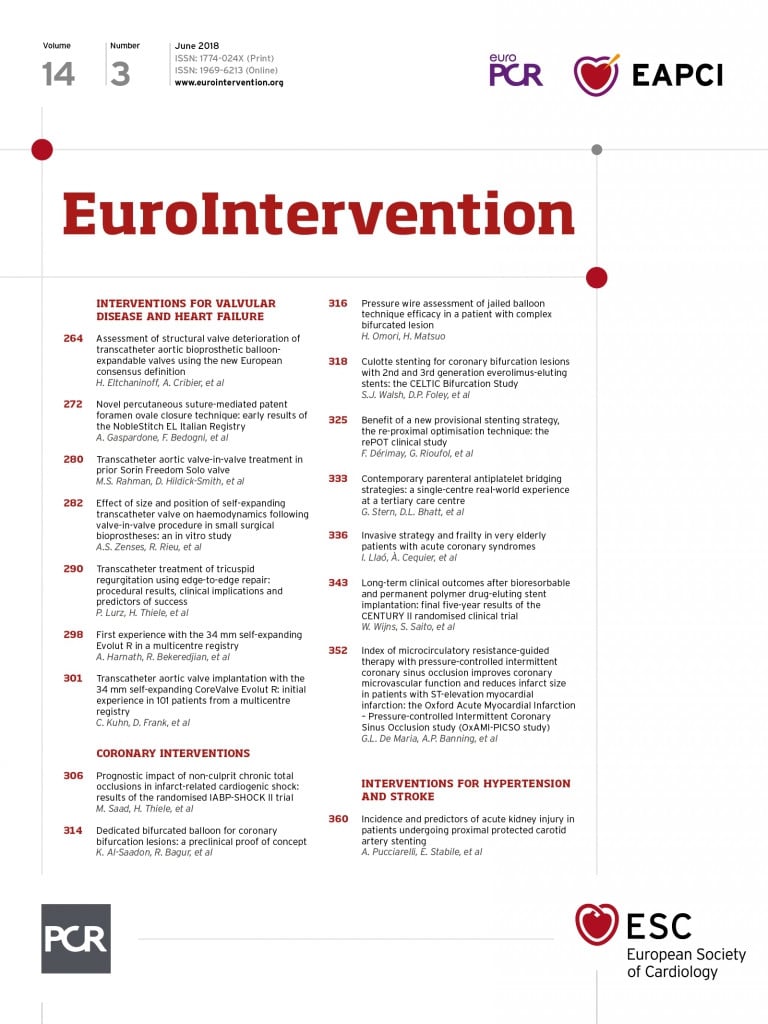

To address the limitations of the two-balloon system for kissing balloon inflation (KBI) for the treatment of coronary bifurcation lesions (CBL), we report a novel coronary dedicated bifurcated balloon (DBB) catheter system (Panel A).
In an in vivo study, the DBB catheter was compared to the KBI technique in post-stent deployment of a bifurcation of a normal 65 kg swine, Yorkshire cross breed. Percutaneous coronary intervention of the right coronary artery (RCA) was performed using a 3.0×28 mm stent in the main branch (MB), jailing the posterolateral (PLA) side branch (SB). Then, a 1.5×20 mm balloon was used to open the stent struts towards the PLA branch. Afterwards, a 2.25×24 mm stent was deployed in the PLA branch. Finally, KBI was performed with a 3.0×20 mm balloon in the MB and a 2.0×15 mm balloon for the SB at 10 atmospheres. Therefore, the balloon-to-vessel ratio at the proximal MB was 1.66. An angiographic image is shown in Panel B.
Subsequently, we selectively cannulated the left circumflex (LCx) coronary artery and deployed a 3.0×32 mm stent in the MB jailing the first obtuse marginal (OM1) branch, then used the DBB catheter prototype (Panel C) instead of the KBI technique. The DBB comprises a tapered 30 mm (length) balloon that is 3.5 mm in diameter in the proximal part and 3.0 mm in the distal part to treat the MB. The SB component of the DBB comprises a 2.5×30 mm balloon. Note, both balloons are semi-compliant. The balloon-to-vessel ratio in the proximal MB was 1.16. An angiographic image is shown in Panel D.
The animal was euthanised. X-rays were taken of the heart and the coronary arteries were filled with silicone. Notably, an overstretching of the proximal portion of the stent in the RCA can be appreciated (Panel E, Panel F), while not in the LCx stent using the DBB catheter (Panel G, Panel H, dotted arrow). Importantly, the ostial segment or “connecting neck” of the side branch balloon (Panel A) is positioned in the MB bifurcation; thus, the actual diameter of the side branch balloon is meant to cover the ostium fully.
A new, refined, 6 Fr-compatible DBB prototype will be preclinically tested and compared head-to-head with single and two-stent strategies before being clinically trialled. The new design of DBB will have two rapid exchange wire runs in two separate channels, thus assuring an easier advancement of the DBB. Finally, the use of intravascular imaging would allow determining the presence and degree of overstretching.
In this preclinical proof-of-concept study, we demonstrate the feasibility of using a DBB for the treatment of CBL, though these results should be interpreted with caution due to the nature of the study. The use of a DBB may potentially replace final KBI and avoid wire overlap, while preserving the desired optimal anatomy.
Conflict of interest statement
K. Al-Saadon is the inventor and owns the patent for the device- “Stent System, deployment apparatus and method for bifurcated lesion” (US patent 2017/0007431 A1; Jan 12, 2017. https://encrypted.google.com/patents/US20170007431). The other authors have no conflicts of interest to declare.
Supplementary data
Moving image 1. Dedicated bifurcated balloon. Conception and design.
Moving image 2. Dedicated bifurcated balloon. Bench testing.
Supplementary data
To read the full content of this article, please download the PDF.
Moving image 1. Dedicated bifurcated balloon. Conception and design.
Moving image 2. Dedicated bifurcated balloon. Bench testing.

